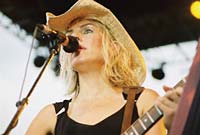
“That should be the porch up there,” says Nathan Harlow,front-of-house engineer for Lucinda Williams, gesturing toward thestage of New York’s Beacon Theatre, barren but for a drum kit, amps andmic stands.
Williams, touring behind her Lost Highway Records release, WorldWithout Tears, makes any stage her own, bringing her homey,Southern sensibility to any setting, be it an Austin roadhouse or anUpper West Side theater.
Armed with a 1954 Fender Esquire or Gibson J-45 acoustic guitar,Williams is spellbinding — 3,000 New Yorkers hang on every note:country rockers, and plaintive, solo acoustic performances alike.Four-piece band and audience, nothing separates the two. Williams’heartfelt, wistful voice fills the theater, complemented by DougPettibone’s outstanding guitar work. Tremolo, pedal steel and the twangof countrified rock ‘n’ roll twang wash over the crowd.
Harlow is new to Williams’ crew but he is a veteran of innumerablegigs at San Francisco’s Fillmore and Warfield Theaters, along withmultiple world tours, including the Further Festival, Primus, Princeand Rob Zombie. With Williams, however, variety can be found from onenight to the next.
“We play tiny cowboy clubs with an Allen & Heath [console]or less,” he says. “We did some in Austin; little shows.They came off great, because she loves that environment. And then we dolarge venues with huge systems. You’ve got to go between the two ofthem.”
Perhaps to reflect the simplicity of her superb songwriting andstraightforward delivery, the tour carries very little hardware; infact, Harlow carries just one rack. Local sound reinforcement companiesprovide loudspeaker arrays, consoles, wedges and additional outboardgear, with RSA Audio Services of Edgewood, N.Y., handling the twoBeacon dates.

“I use the Symetrix [551E 5-band] parametrics, two channelsfor the mains,” Harlow explains. “I just plug that in-linebefore their drive system. Typically, I’m only using two or threefilters to tighten up the low end.
“I have an ATI Pro 6,” Harlow continues, pointing to themultimode processor. “It has a preamp, highpass/lowpass filters,parametric EQ, compressor and a gate that I never use. I inserted a BSS901 for her voice; the frequency-dependent EQ really helps, because shegoes from sultry to loud, and her lyrics are most important.”
For the Beacon Theatre, RSA provided Yamaha PM4000 consoles for boththe FOH and monitor positions. Also at FOH are dbx 160 and 160XTcompressor/limiters and a 166XL compressor/limiter/gate. Other effectsinclude a pair of Klark-Teknik DN300 graphic EQs, Yamaha SPX900 andSPX990 multi-effects processors, a Lexicon PCM 80, a Roland SDE-3000Adigital delay, a Behringer Ultra Curve and an Eventide H3000SE UltraHarmonizer.
“I moderately compress the kick drum channels, bass DIchannels and her acoustic channels,” says Harlow. “They gofrom a real soft, brushstroke-y snare to good, country-rock beats. Itry to get that in a pocket, but not so squished that everything’s thesame. Then I do a drum subgroup, and then just compress the twobackground vocals, as I already have my vocal rack for Lucinda. The‘visiting’ compressors are dbx tonight. We’ll see what wehave tomorrow night.”
Williams endorses Audix microphones. She and bandmates Pettibone,Taras Prodaniuk (bass) and Jimmy Christie (drums) rely on a complementof OM-6, D-3 and D-4 mics. “The one thing I’ve been changing outis the vocal mic,” says Harlow. “[Audix] sent out their new[VX-10] condenser vocal mic, and it’s good. I used it just last night,and I’ll use it again tonight.
“I’ve also been playing with different kick drum mics,”Harlow adds. “Right now, we have the Audio-Technica dual-element— the [AE2500] condenser and dynamic — which is reallynice. Jimmy wanted to check it out, and I know he’s going to love itfor recording at home. He does a lot of that.”
To power the “back porch,” RSA supplied a JBL VerTecline array system. “We just bought the VerTecs a little less thana year ago,” says RSA audio engineer Mike Murphy. “We’re inthe process of changing over power, but we’re still using the Carverracks that we had from our conventional full-rig system. So everythingthat’s here is Carver PM 1.5s.”
The outboard supplement at the monitor position is similar to FOH,says Harlow, with additional Klark-Teknik EQs. “We use nocompression, reverb or gates in the monitors,” he says.“That’s all pretty natural. With this band, coming from thesource, my job is to keep it clean and natural. It’s really about soundreinforcement, as opposed to sound enforcement. I’m not trying tochange anything; I’m just trying to make it a little bigger.
“She’s an important artist, somebody who needs to beheard,” he adds. “It’s a pleasure to try to get her lyricsacross. Everybody feels like she’s singing to thempersonally.”
Christopher Walsh is a veteran pro audio journalist.



